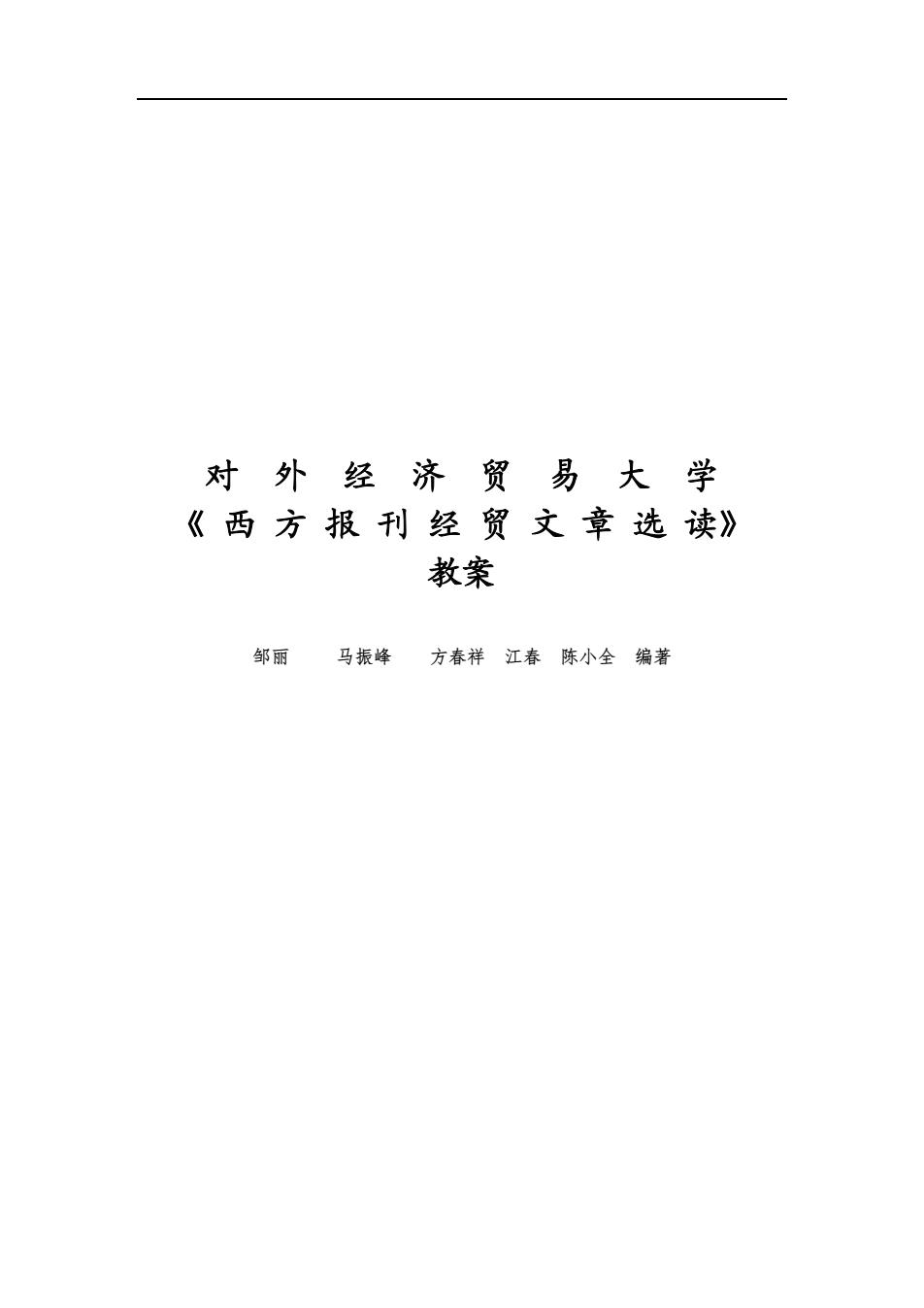
对外经济贸易大学 《西方报刊经贸文章选读》 教案 邹丽 马振峰 方春祥江春陈小全编著
对 外 经 济 贸 易 大 学 《 西 方 报 刊 经 贸 文 章 选 读》 教案 邹丽 马振峰 方春祥 江春 陈小全 编著
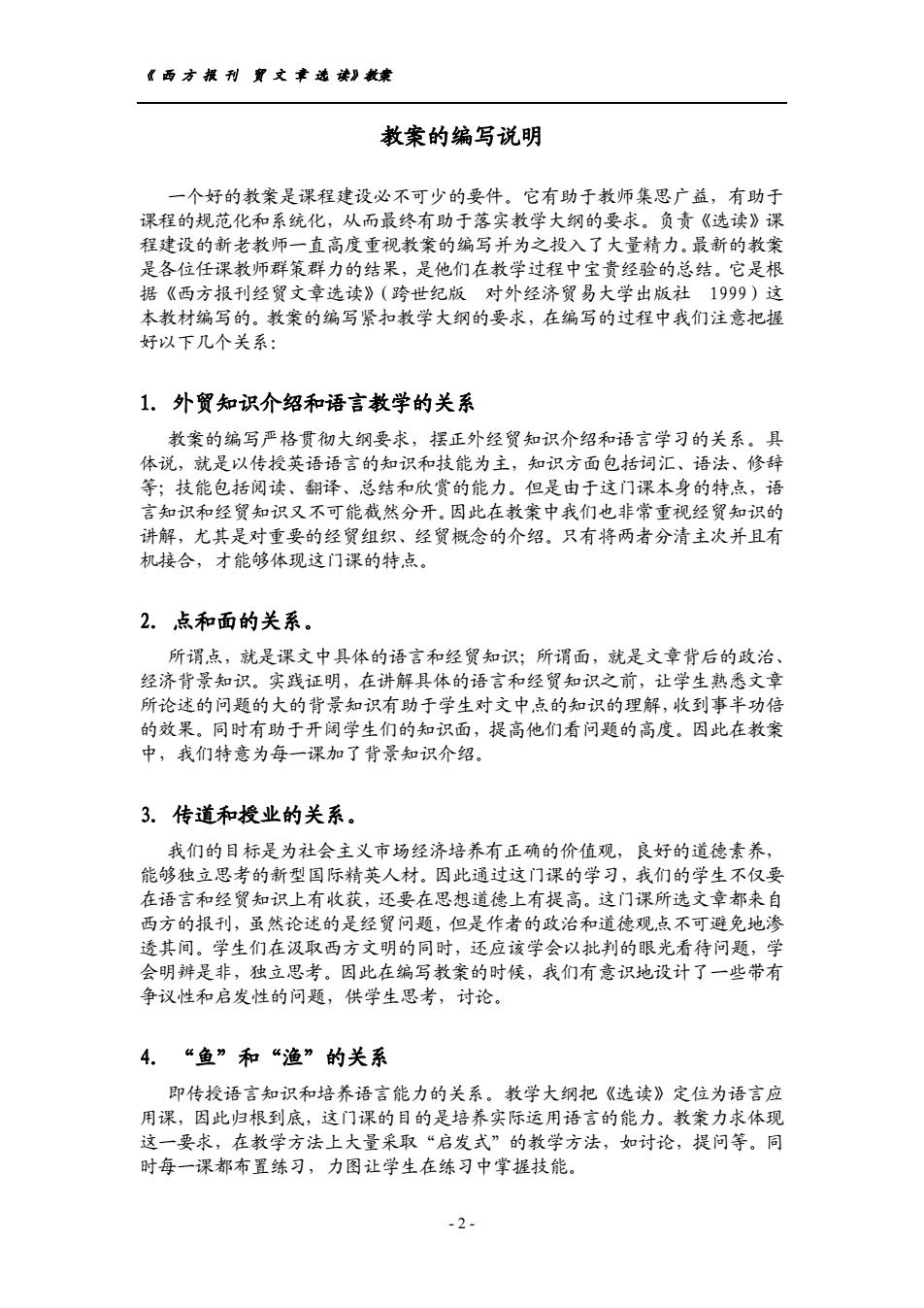
《西方报刊贸文章边读》教球 教案的编写说明 一个好的教案是课程建设必不可少的要件。它有助于教师集思广益,有助于 课程的规范化和系统化,从而最终有助于落实教学大纲的要求。负责《选读》课 程建设的新老教师一直高度重视教案的编写并为之投入了大量精力。最新的教案 是各位任课教师群策群力的结果,是他们在教学过程中宝贵经验的总结。它是根 据《西方报刊经贸文章选读》(跨世纪版对外经济贸易大学出版社1999)这 本教材编写的。教案的编写紧扣教学大纲的要求,在编写的过程中我们注意把握 好以下几个关系: 1.外贸知识介绍和语言教学的关系 教案的编写严格贯彻大纲要求,摆正外经贸知识介绍和语言学习的关系。具 体说,就是以传授英语语言的知识和技能为主,知识方面包括词汇、语法、修辞 等;技能包括阅读、翻译、总结和欣赏的能力。但是由于这门课本身的特点,语 言知识和经贸知识又不可能截然分开。因此在教案中我们也非常重视经贸知识的 讲解,尤其是对重要的经贸组织、经贸概念的介绍。只有将两者分清主次并且有 机接合,才能够体现这门课的特点。 2.点和面的关系。 所谓点,就是课文中具体的语言和经贸知识;所谓面,就是文章背后的政治」 经济背景知识。实践证明,在讲解具体的语言和经贸知识之前,让学生熟悉文章 所论述的问题的大的背景知识有助于学生对文中点的知识的理解,收到事半功倍 的效果。同时有助于开阔学生们的知识面,提高他们看问题的高度。因此在教案 中,我们特意为每一课加了背景知识介绍。 3.传道和授业的关系。 我们的目标是为社会主义市场经济培养有正确的价值观,良好的道德素养, 能够独立思考的新型国际精英人材。因此通过这门课的学习,我们的学生不仅要 在语言和经贸知识上有收获,还要在思想道德上有提高。这门课所选文章都来自 西方的报刊,虽然论述的是经贸问题,但是作者的政治和道德观,点不可避免地渗 透其间。学生们在汲取西方文明的同时,还应该学会以批判的眼光看待问题,学 会明辨是非,独立思考。因此在编写教案的时候,我们有意识地设计了一些带有 争议性和启发性的问题,供学生思考,讨论。 4.“鱼”和“渔”的关系 即传授语言知识和培养语言能力的关系。教学大纲把《选读》定位为语言应 用课,因此归根到底,这门课的目的是培养实际运用语言的能力。教案力求体现 这一要求,在教学方法上大量采取“启发式”的教学方法,如讨论,提问等。同 时每一课都布置练习,力图让学生在练习中掌握技能。 -2-
《 西 方 报 刊 贸 文 章 选 读》教案 - 2 - 教案的编写说明 一个好的教案是课程建设必不可少的要件。它有助于教师集思广益,有助于 课程的规范化和系统化,从而最终有助于落实教学大纲的要求。负责《选读》课 程建设的新老教师一直高度重视教案的编写并为之投入了大量精力。最新的教案 是各位任课教师群策群力的结果,是他们在教学过程中宝贵经验的总结。它是根 据《西方报刊经贸文章选读》(跨世纪版 对外经济贸易大学出版社 1999)这 本教材编写的。教案的编写紧扣教学大纲的要求,在编写的过程中我们注意把握 好以下几个关系: 1.外贸知识介绍和语言教学的关系 教案的编写严格贯彻大纲要求,摆正外经贸知识介绍和语言学习的关系。具 体说,就是以传授英语语言的知识和技能为主,知识方面包括词汇、语法、修辞 等;技能包括阅读、翻译、总结和欣赏的能力。但是由于这门课本身的特点,语 言知识和经贸知识又不可能截然分开。因此在教案中我们也非常重视经贸知识的 讲解,尤其是对重要的经贸组织、经贸概念的介绍。只有将两者分清主次并且有 机接合,才能够体现这门课的特点。 2.点和面的关系。 所谓点,就是课文中具体的语言和经贸知识;所谓面,就是文章背后的政治、 经济背景知识。实践证明,在讲解具体的语言和经贸知识之前,让学生熟悉文章 所论述的问题的大的背景知识有助于学生对文中点的知识的理解,收到事半功倍 的效果。同时有助于开阔学生们的知识面,提高他们看问题的高度。因此在教案 中,我们特意为每一课加了背景知识介绍。 3.传道和授业的关系。 我们的目标是为社会主义市场经济培养有正确的价值观,良好的道德素养, 能够独立思考的新型国际精英人材。因此通过这门课的学习,我们的学生不仅要 在语言和经贸知识上有收获,还要在思想道德上有提高。这门课所选文章都来自 西方的报刊,虽然论述的是经贸问题,但是作者的政治和道德观点不可避免地渗 透其间。学生们在汲取西方文明的同时,还应该学会以批判的眼光看待问题,学 会明辨是非,独立思考。因此在编写教案的时候,我们有意识地设计了一些带有 争议性和启发性的问题,供学生思考,讨论。 4.“鱼”和“渔”的关系 即传授语言知识和培养语言能力的关系。教学大纲把《选读》定位为语言应 用课,因此归根到底,这门课的目的是培养实际运用语言的能力。教案力求体现 这一要求,在教学方法上大量采取“启发式”的教学方法,如讨论,提问等。同 时每一课都布置练习,力图让学生在练习中掌握技能

《西方报刊贸文章边读》教球 5.共性和个性的关系。 作为一门自成体系的课程,《选读》的各位任课教师自然应当在教学方法、 教学内容和测试方法等方面保持必要的统一性。但是,我们也不应该用统一性的 名义压制教师在教学过程中的创造性。相反,我们鼓励教师在教学方法等方面百 花齐放,在教学实践中证明是有效的一些做法将积极加以推广,最终成为这门课 程共性的东西。实际上,这个教案所体现的一些教学方法,就是各位教师经验的 总结和升华。共性和个性关系的另外一层意思是,教案根据每篇课文不同的特点, 有针对性地选择教学方法,确定教学重点,而不是一成不变。 6.重点和非重点的关系。 由于教材的课文篇幅大都较长,所以教案不应面面俱到。本着突出重点的原 则,教案重点涉及学生不熟悉的背景知识的介绍,语法难点的讲解和修辞手法的 欣赏。 7.稳定性和发展性的关系。 因为教案是对教师在一定时期内教学经验的总结,是大纲精神的重要体现, 因此一个教案一旦确定下来,它应在内容和体例上保持一定的稳定性。但是,教 案同时更应该是一潭活水,它应该随着教学实践的发展而不断充实和完善。因此, 我们的教案从根本上来说是开放式的。我们一般每隔两个学期对教案评估一次, 进行充实完善,确保教案在稳定中得到发展。 按照教材的顺序,教案共分20课。从体例上来讲,教案包括以下具体内容: 1.教学目的 包括传授知识方面的目的和培养技能方面的目的。每一课教案的编写都围绕 着教学目的展开。 2.教学计划 主要涉及教学时间的安排。根据课文的难易程度和篇幅的长短,每篇课文所 用的时间有所不同,但是每位教师都应该按照总学时的要求安排教学进度。 3.教学方法 教案主要采用的教学方法有:提问法,讨论法,翻译法,英语释义法,总结 法,阅读理解法,等。教案根据每课不同的特点提出了不同的教学方法组合。 4.背景知识介绍: 主要介绍文章所述问题发生的社会、政治和经济背景,从而有助于学生更好 地理解文章。 5.概念: 主要介绍一些重要的经贸术语和概念。这是正确理解此类文章重要的一环。 6.重点讲解: 这是教案的主体部分。针对课文中出现的一些语言和经贸知识方面的重点和 难点,教案分别加以较详细的解释。目的是让教师在教课的过程中更有针对性, 做到重点突出。 -3-
《 西 方 报 刊 贸 文 章 选 读》教案 - 3 - 5.共性和个性的关系。 作为一门自成体系的课程,《选读》的各位任课教师自然应当在教学方法、 教学内容和测试方法等方面保持必要的统一性。但是,我们也不应该用统一性的 名义压制教师在教学过程中的创造性。相反,我们鼓励教师在教学方法等方面百 花齐放,在教学实践中证明是有效的一些做法将积极加以推广,最终成为这门课 程共性的东西。实际上,这个教案所体现的一些教学方法,就是各位教师经验的 总结和升华。共性和个性关系的另外一层意思是,教案根据每篇课文不同的特点, 有针对性地选择教学方法,确定教学重点,而不是一成不变。 6.重点和非重点的关系。 由于教材的课文篇幅大都较长,所以教案不应面面俱到。本着突出重点的原 则,教案重点涉及学生不熟悉的背景知识的介绍,语法难点的讲解和修辞手法的 欣赏。 7.稳定性和发展性的关系。 因为教案是对教师在一定时期内教学经验的总结,是大纲精神的重要体现, 因此一个教案一旦确定下来,它应在内容和体例上保持一定的稳定性。但是,教 案同时更应该是一潭活水,它应该随着教学实践的发展而不断充实和完善。因此, 我们的教案从根本上来说是开放式的。我们一般每隔两个学期对教案评估一次, 进行充实完善,确保教案在稳定中得到发展。 按照教材的顺序,教案共分 20 课。从体例上来讲,教案包括以下具体内容: 1. 教学目的 包括传授知识方面的目的和培养技能方面的目的。每一课教案的编写都围绕 着教学目的展开。 2. 教学计划 主要涉及教学时间的安排。根据课文的难易程度和篇幅的长短,每篇课文所 用的时间有所不同,但是每位教师都应该按照总学时的要求安排教学进度。 3. 教学方法 教案主要采用的教学方法有:提问法,讨论法,翻译法,英语释义法,总结 法,阅读理解法,等。教案根据每课不同的特点提出了不同的教学方法组合。 4. 背景知识介绍: 主要介绍文章所述问题发生的社会、政治和经济背景,从而有助于学生更好 地理解文章。 5. 概念: 主要介绍一些重要的经贸术语和概念。这是正确理解此类文章重要的一环。 6. 重点讲解: 这是教案的主体部分。针对课文中出现的一些语言和经贸知识方面的重点和 难点,教案分别加以较详细的解释。目的是让教师在教课的过程中更有针对性, 做到重点突出
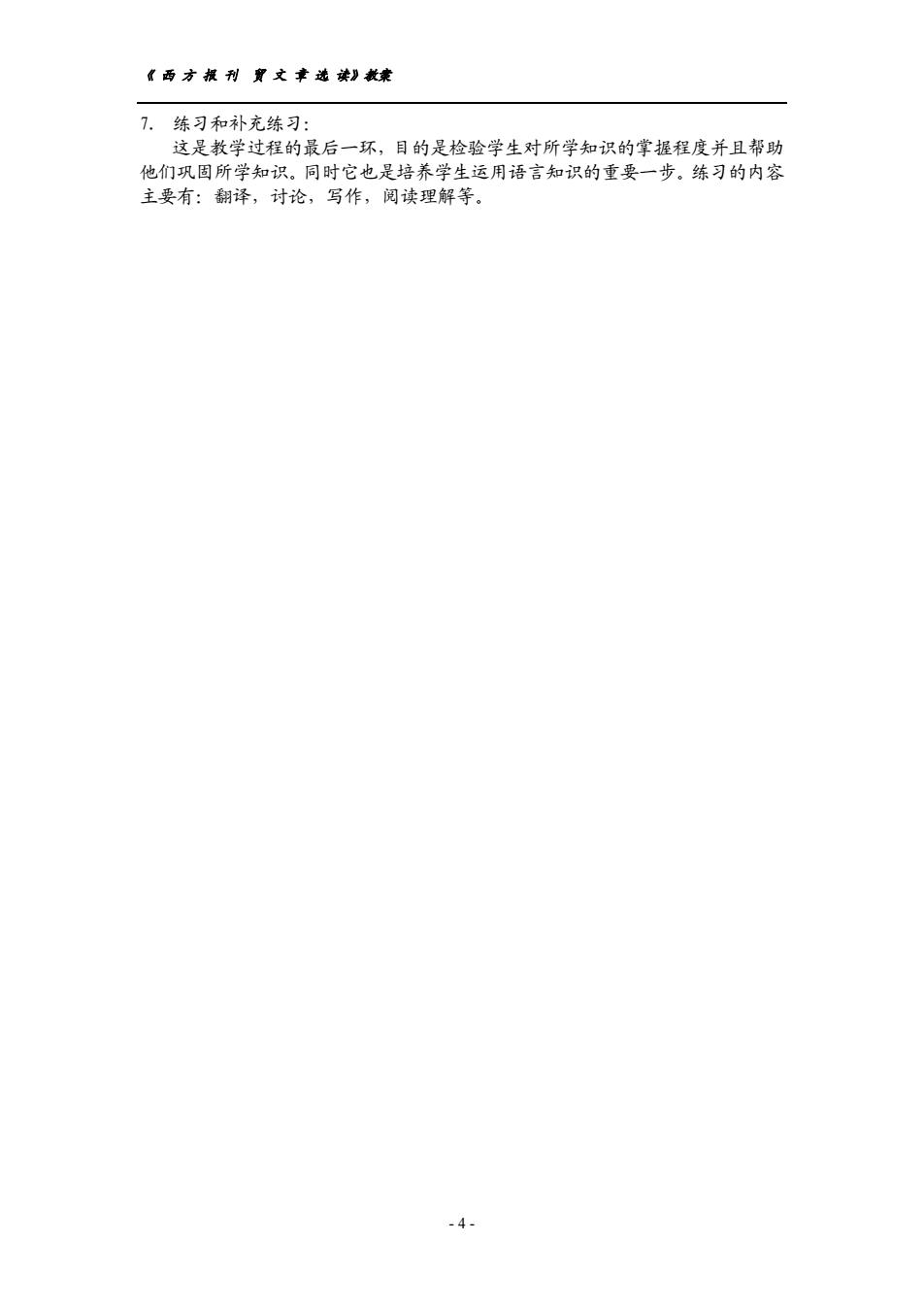
《西方报刊寶文章进读》教隶 7.练习和补充练习: 这是教学过程的最后一环,目的是检验学生对所学知识的掌握程度并且帮助 他们巩固所学知识。同时它也是培养学生运用语言知识的重要一步。练习的内容 主要有:翻译,讨论,写作,阅读理解等。 -4-
《 西 方 报 刊 贸 文 章 选 读》教案 - 4 - 7. 练习和补充练习: 这是教学过程的最后一环,目的是检验学生对所学知识的掌握程度并且帮助 他们巩固所学知识。同时它也是培养学生运用语言知识的重要一步。练习的内容 主要有:翻译,讨论,写作,阅读理解等

《西方报刊贸文章边读》教球 目 录 第一课China In The Market Place- 第二课The Curtain Goes Up---- ----10 第三课Beijing Rising------- ---16 第四课The Economic Scene:A Global Perspective-- 23 第五课Us Is Prepared to See Trade Relations Worsen--------------27 第六课Economic Troubles Cloud New Market's Future- ---31 第七课Japan Says No------ -34 第八课Here Comes Korea,Inc.----- ----37 第九课Prosperity Persists in the UAE--- ----41 第十课Freer Trade,With Luck----- -----45 第十一课The Comeback of International Barter---- -----49 第十二课Soft Drink Wars:The Next Battle----- ----52 第十三课Honk Kong Is Tops At Cracking U.S.Shell Eggs----- ----56 第十四课Soft Commodities--- ---58 第十五课Veekly Commodities- --63 第十六课Off And Running-- 67 第十七课New Worlds To Conquer--- -----------71 第十八课The Tug of War On Textiles-- --77 第十九课A Big Hit In The Stores--------- ---------81 第二十课An Oil Crisis Knocks On Recovery's Door-------------- 83 -5-
《 西 方 报 刊 贸 文 章 选 读》教案 - 5 - 目 录 第一课 China In The Market Place - - - - - - - - - - - - - - - - - - - - - - - - - - - - - -- 6 第二课 The Curtain Goes Up - - - - - - - - - - - - - - - -- - - - - - - - - - - - -- - - -- - - 10 第三课 Beijing Rising - - - - - - - - - - - - - - - - - - - - - - - - - - - - -- - - - - - - - - - - -16 第四课 The Economic Scene: A Global Perspective - - - - - - - - - - - - - - - - - - - 23 第五课 Us Is Prepared to See Trade Relations Worsen - - - - - - -- - - - - - - - - --27 第六课 EconomicTroublesCloudNewMarket’sFuture- - - - - - - - - - - - - - - -31 第七课 Japan Says No - - - - - - - - - - - - - - - - - -- - - - - - - - - - - -- - - - - - - - - -- -34 第八课 Here Comes Korea, Inc. - - - - - - - - - - - - - - - - - - - - - - - - - - - - -- - - - - 37 第九课 Prosperity Persists in the UAE - - - - - - - - - - - - - - - -- - - - - - - -- - - - - - 41 第十课 Freer Trade,With Luck - - - -- - - - - - - - - - - - - - - - - - - - - - - - - - -45 第十一课 The Comeback of International Barter - - - - - - - - - - - -- - - - - - - - - -49 第十二课 Soft Drink Wars: The Next Battle - - - - -- - - - - - - - - - - - - - - - - - - - -52 第十三课 Honk Kong Is Tops At Cracking U.S. Shell Eggs - - - - - - - - - - - - -- - 56 第十四课Soft Commodities - - - - - - - - - - - - - - - - - - - - - - - - - - - - - - - - -- - - -- 58 第十五课 Weekly Commodities - - - - - - - - - - - -- - - - - - - - - - - - - - -- - - -- -- 63 第十六课 Off And Running - - - - - -- - - - - -- - - - - - - -- - - - -- - - -- - - -- - -- - 67 第十七课 New Worlds To Conquer - - - - -- - - - -- - - - - - - - - - - -- - - - - -- - -- - - 71 第十八课The Tug of War On Textiles - - - - - - - -- - - - - - - - - - - - - - -- - -- - -- 77 第十九课 A Big Hit In The Stores - - - -- - - - - - - - - - - -- - - - - -- - - - -- - -- -- - - 81 第二十课 AnOilCrisisKnocksOnRecovery’sDoor- -- - - -- - - - -- - - - - - -- 83
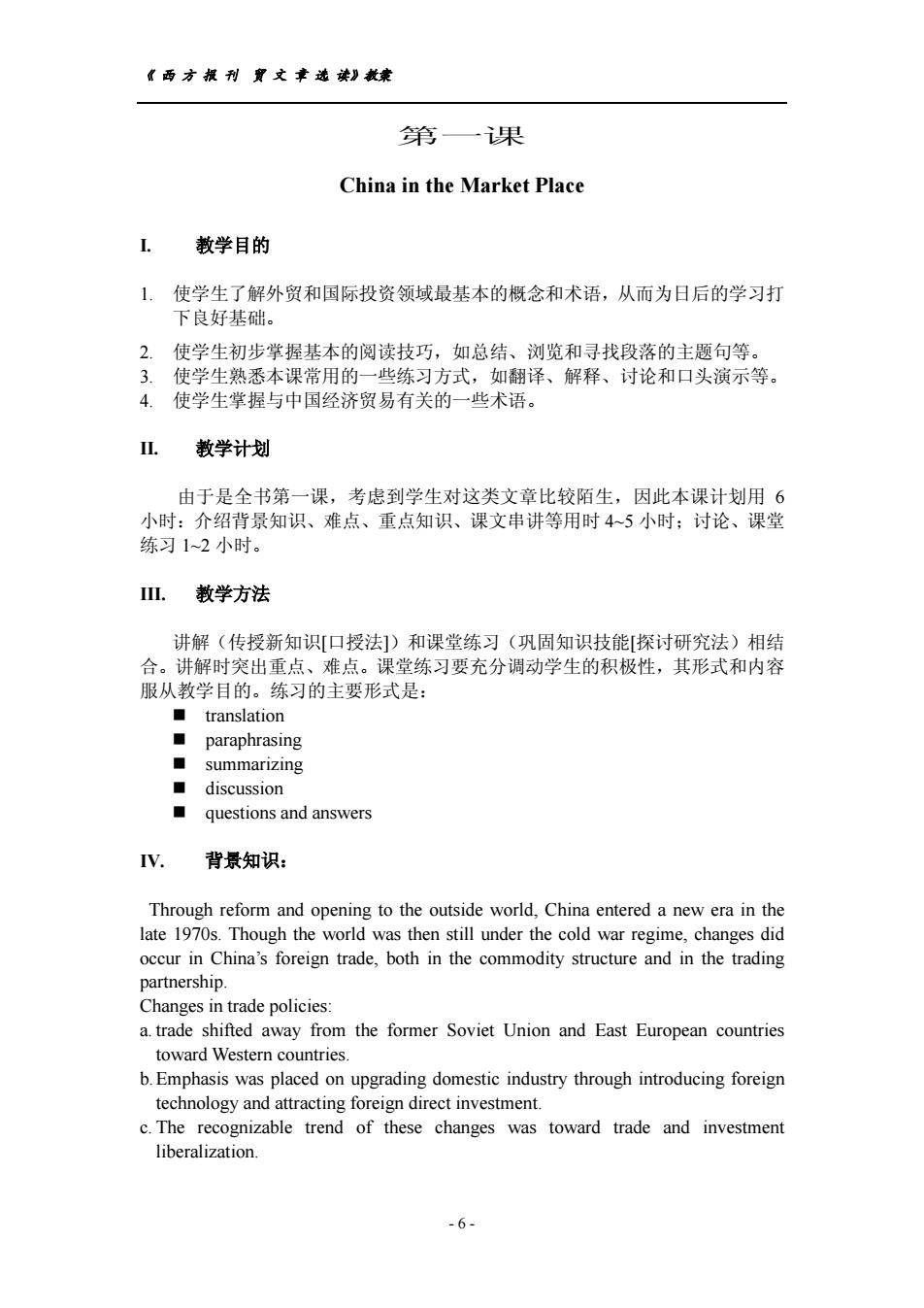
《西方报刊贸文章进读》教策 第一果 China in the Market Place 教学目的 1.使学生了解外贸和国际投资领域最基本的概念和术语,从而为日后的学习打 下良好基础。 2. 使学生初步掌握基本的阅读技巧,如总结、浏览和寻找段落的主题句等。 3. 使学生熟悉本课常用的一些练习方式,如翻译、解释、讨论和口头演示等。 4. 使学生掌握与中国经济贸易有关的一些术语。 II. 教学计划 由于是全书第一课,考虑到学生对这类文章比较陌生,因此本课计划用6 小时:介绍背景知识、难点、重点知识、课文串讲等用时4~5小时:讨论、课堂 练习12小时。 . 教学方法 讲解(传授新知识[口授法])和课堂练习(巩固知识技能[探讨研究法)相结 合。讲解时突出重点、难点。课堂练习要充分调动学生的积极性,其形式和内容 服从教学目的。练习的主要形式是: ■ translation 自 paraphrasing ■ summarizing ■ discussion questions and answers IV. 背景知识: Through reform and opening to the outside world,China entered a new era in the late 1970s.Though the world was then still under the cold war regime,changes did occur in China's foreign trade,both in the commodity structure and in the trading partnership Changes in trade policies: a.trade shifted away from the former Soviet Union and East European countries toward Western countries. b.Emphasis was placed on upgrading domestic industry through introducing foreign technology and attracting foreign direct investment. c.The recognizable trend of these changes was toward trade and investment liberalization. -6
《 西 方 报 刊 贸 文 章 选 读》教案 - 6 - 第一课 China in the Market Place I. 教学目的 1. 使学生了解外贸和国际投资领域最基本的概念和术语,从而为日后的学习打 下良好基础。 2. 使学生初步掌握基本的阅读技巧,如总结、浏览和寻找段落的主题句等。 3. 使学生熟悉本课常用的一些练习方式,如翻译、解释、讨论和口头演示等。 4. 使学生掌握与中国经济贸易有关的一些术语。 II. 教学计划 由于是全书第一课,考虑到学生对这类文章比较陌生,因此本课计划用 6 小时:介绍背景知识、难点、重点知识、课文串讲等用时 4~5 小时;讨论、课堂 练习 1~2 小时。 III. 教学方法 讲解(传授新知识[口授法])和课堂练习(巩固知识技能[探讨研究法)相结 合。讲解时突出重点、难点。课堂练习要充分调动学生的积极性,其形式和内容 服从教学目的。练习的主要形式是: translation paraphrasing summarizing discussion questions and answers IV. 背景知识: Through reform and opening to the outside world, China entered a new era in the late 1970s. Though the world was then still under the cold war regime, changes did occurinChina’sforeigntrade,bothinthecommoditystructureandinthetrading partnership. Changes in trade policies: a. trade shifted away from the former Soviet Union and East European countries toward Western countries. b.Emphasis was placed on upgrading domestic industry through introducing foreign technology and attracting foreign direct investment. c. The recognizable trend of these changes was toward trade and investment liberalization

《西方报刊贸文章边读》教球 V. 重点讲解: 概念讲解: 资本设备:(capital equipment) 国际收支:(balance of payment) 经常项目(current account) 有形贸易(visible trade) 无形贸易(invisible trade) 资本项目(capital account) 课文讲解: 课本上所列Notes to the Text以及Questions on Content and Language points (for preview,discussion and review)也属重点讲解之列,但在这儿省略。 1. During the 1950s China exported agricultural products to the USSR and East European countries in return for manufactured goods and the capital equipment required for the country's industrialization program which placed emphasis on the development of heavy industry. 本句中请注意过去分词“required for the country's industrialization program” 作定语,修饰“the capital equipment”;另外,“which”所引导的定语从句修 饰的是“the country's industrialization program”。 译:在20世纪五十年代期间,中国向(前)苏联和东欧各国出口农产品以换 取制成品和国家以发展重工业为重的工业化进程中所需的资本设备。 2.The growth of foreign trade was disrupted again during the Cultural Revolution (1966-76)when agricultural and industrial production fell sharply and transportation constraints became more serious. “when”所引导的从句是定语从句而非状语从句,它修饰的是“during the Cultural Revolution”。 译:外贸的发展在文化大革命期间再次被中断,当时工农业生产急剧下降, 交通的制约问题更加严重。 3. Official recognition that foreign technology could play a major role in modernizing the Chinese economy had caused imports to rise by more than 50 per cent in 1987 placing undue strain on the national economy. 本句的主干是:“Official recognition.had caused imports to rise by more than 50 per cent in 1987"."that foreign technology could play a major role in modernizing the Chinese economy”修饰“Official recognition”;“placing undue strain on the national economy”为现在分词短语,表结果。 译:官方认为外国技术能在中国经济现代化中起重大作用,这使得1987年进 口上升了50%以上,从而给国民经济施加了过重的压力。 -7-
《 西 方 报 刊 贸 文 章 选 读》教案 - 7 - V. 重点讲解: 概念讲解: 资本设备: (capital equipment) 国际收支:(balance of payment) 经常项目(current account) 有形贸易(visible trade) 无形贸易(invisible trade) 资本项目(capital account) 课文讲解: 课本上所列 Notes to the Text 以及 Questions on Content and Language points (for preview, discussion and review)也属重点讲解之列,但在这儿省略。 1. During the 1950s China exported agricultural products to the USSR and East European countries in return for manufactured goods and the capital equipment requiredforthecountry’sindustrializationprogramwhichplacedemphasisonthe development of heavy industry. 本句中请注意过去分词“requiredforthecountry’sindustrializationprogram” 作定语,修饰“the capital equipment”;另外,“which”所引导的定语从句修 饰的是“thecountry’sindustrializationprogram”。 译:在 20 世纪五十年代期间,中国向(前)苏联和东欧各国出口农产品以换 取制成品和国家以发展重工业为重的工业化进程中所需的资本设备。 2. The growth of foreign trade was disrupted again during the Cultural Revolution (1966—76) when agricultural and industrial production fell sharply and transportation constraints became more serious. “when”所引导的从句是定语从句而非状语从句,它修饰的是“during the Cultural Revolution”。 译:外贸的发展在文化大革命期间再次被中断,当时工农业生产急剧下降, 交通的制约问题更加严重。 3. Official recognition that foreign technology could play a major role in modernizing the Chinese economy had caused imports to rise by more than 50 per cent in 1987 placing undue strain on the national economy. 本句的主干是:“Official recognition … hadcausedimportstorisebymore than 50 per cent in 1987”。“that foreign technology could play a major role in modernizing the Chinese economy”修饰“Official recognition”;“placing undue strain on the national economy” 为现在分词短语,表结果。 译:官方认为外国技术能在中国经济现代化中起重大作用,这使得 1987 年进 口上升了 50%以上,从而给国民经济施加了过重的压力
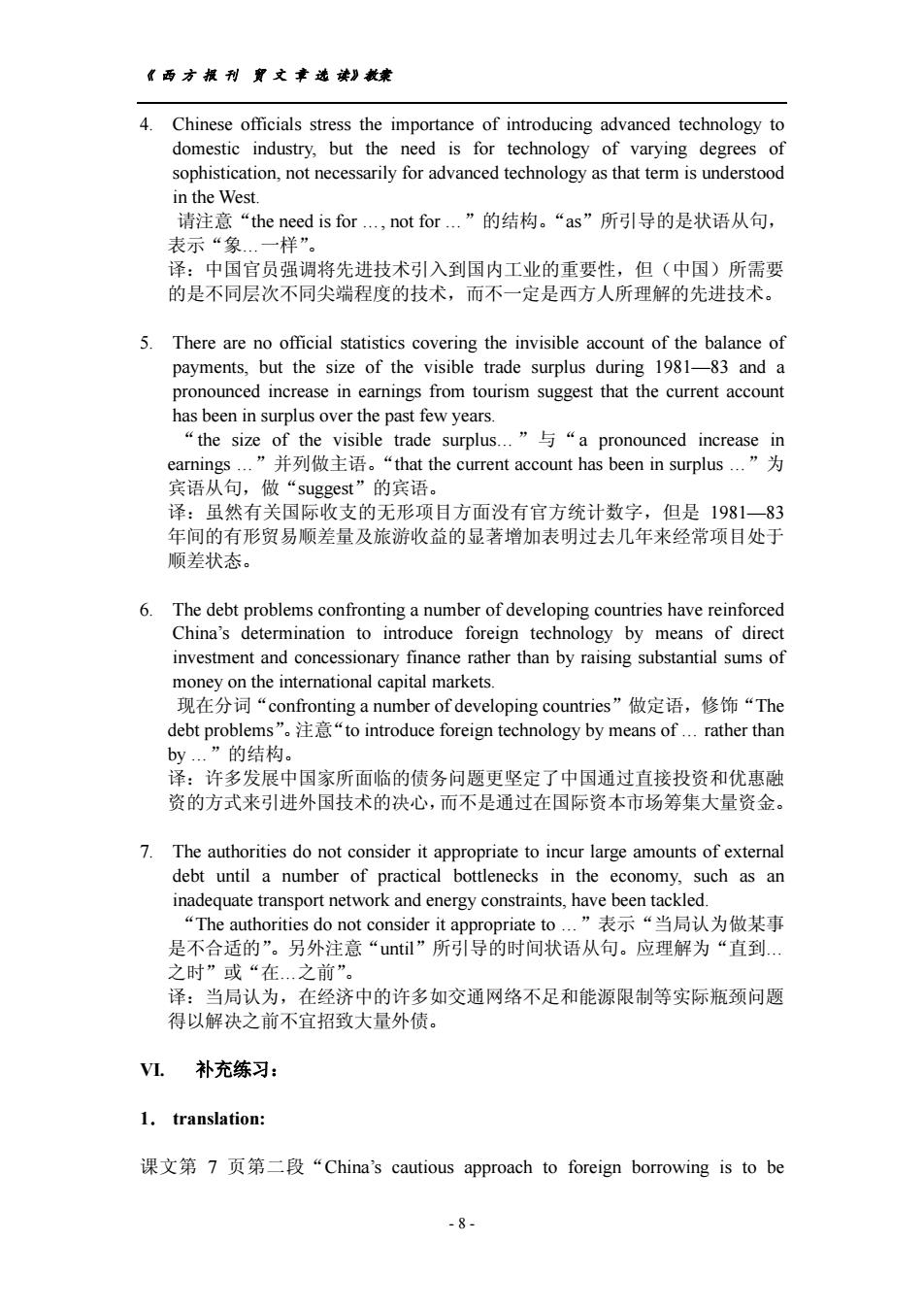
《西方报刊贸文章选读》教策 4. Chinese officials stress the importance of introducing advanced technology to domestic industry,but the need is for technology of varying degrees of sophistication,not necessarily for advanced technology as that term is understood in the West. 请注意“the need is for.,not for..”的结构。“as”所引导的是状语从句, 表示“象.一样”。 译:中国官员强调将先进技术引入到国内工业的重要性,但(中国)所需要 的是不同层次不同尖端程度的技术,而不一定是西方人所理解的先进技术。 5.There are no official statistics covering the invisible account of the balance of payments,but the size of the visible trade surplus during 1981-83 and a pronounced increase in earnings from tourism suggest that the current account has been in surplus over the past few years. “the size of the visible trade surplus..”与“a pronounced increase in earnings..”并列做主语。“that the current account has been in surplus..”为 宾语从句,做“suggest”"的宾语。 译:虽然有关国际收支的无形项目方面没有官方统计数字,但是1981一83 年间的有形贸易顺差量及旅游收益的显著增加表明过去几年来经常项目处于 顺差状态。 6.The debt problems confronting a number of developing countries have reinforced China's determination to introduce foreign technology by means of direct investment and concessionary finance rather than by raising substantial sums of money on the international capital markets. 现在分词“confronting a number of developing countries”做定语,修饰“The debt problems"”。注意“to introduce foreign technology by means of..rather than by..”的结构。 译:许多发展中国家所面临的债务问题更坚定了中国通过直接投资和优惠融 资的方式来引进外国技术的决心,而不是通过在国际资本市场筹集大量资金。 7.The authorities do not consider it appropriate to incur large amounts of external debt until a number of practical bottlenecks in the economy,such as an inadequate transport network and energy constraints,have been tackled. “The authorities do not consider it appropriate to.”表示“当局认为做某事 是不合适的”。另外注意“util”所引导的时间状语从句。应理解为“直到. 之时”或“在.之前”。 译:当局认为,在经济中的许多如交通网络不足和能源限制等实际瓶颈问题 得以解决之前不宜招致大量外债。 VI 补充练习: 1.translation: 课文第7页第二段“China's cautious approach to foreign borrowing is to be -8-
《 西 方 报 刊 贸 文 章 选 读》教案 - 8 - 4. Chinese officials stress the importance of introducing advanced technology to domestic industry, but the need is for technology of varying degrees of sophistication, not necessarily for advanced technology as that term is understood in the West. 请注意“theneedisfor…,notfor…”的结构。“as”所引导的是状语从句, 表示“象…一样”。 译:中国官员强调将先进技术引入到国内工业的重要性,但(中国)所需要 的是不同层次不同尖端程度的技术,而不一定是西方人所理解的先进技术。 5. There are no official statistics covering the invisible account of the balance of payments, but the size of the visible trade surplus during 1981—83 and a pronounced increase in earnings from tourism suggest that the current account has been in surplus over the past few years. “the size of the visible trade surplus…”与“a pronounced increase in earnings…”并列做主语。“that the current account has been in surplus …”为 宾语从句,做“suggest”的宾语。 译:虽然有关国际收支的无形项目方面没有官方统计数字,但是 1981—83 年间的有形贸易顺差量及旅游收益的显著增加表明过去几年来经常项目处于 顺差状态。 6. The debt problems confronting a number of developing countries have reinforced China’sdeterminationtointroduceforeigntechnologybymeansofdirect investment and concessionary finance rather than by raising substantial sums of money on the international capital markets. 现在分词“confronting a number of developing countries”做定语,修饰“The debt problems”。注意“tointroduceforeigntechnologybymeansof… ratherthan by…”的结构。 译:许多发展中国家所面临的债务问题更坚定了中国通过直接投资和优惠融 资的方式来引进外国技术的决心,而不是通过在国际资本市场筹集大量资金。 7. The authorities do not consider it appropriate to incur large amounts of external debt until a number of practical bottlenecks in the economy, such as an inadequate transport network and energy constraints, have been tackled. “Theauthoritiesdonotconsideritappropriateto…”表示“当局认为做某事 是不合适的”。另外注意“until”所引导的时间状语从句。应理解为“直到… 之时”或“在…之前”。 译:当局认为,在经济中的许多如交通网络不足和能源限制等实际瓶颈问题 得以解决之前不宜招致大量外债。 VI. 补充练习: 1. translation: 课文第 7 页第二段“China’scautiousapproachtoforeignborrowingistobe
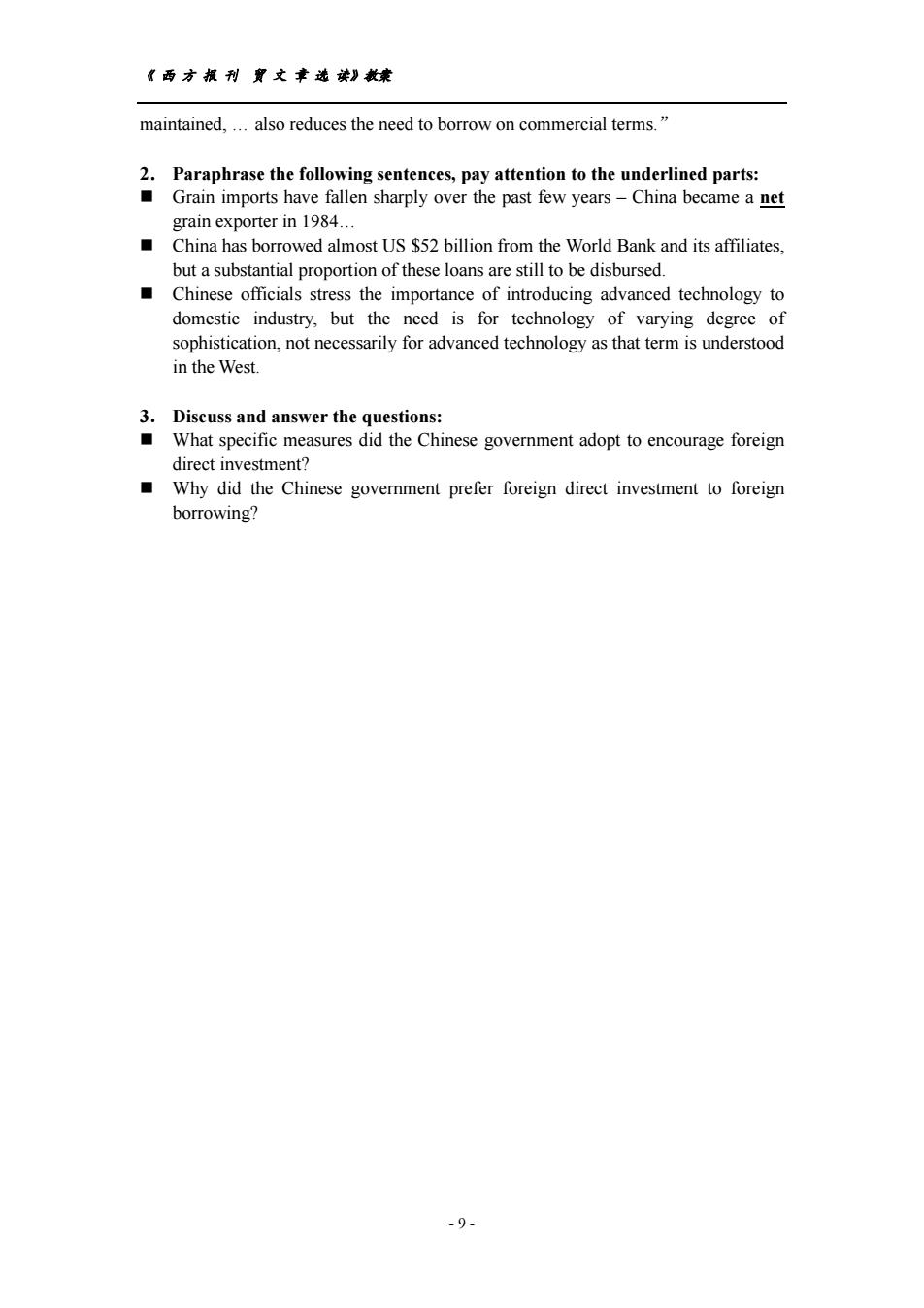
《西方报刊贸文章边读》教球 maintained,...also reduces the need to borrow on commercial terms. 2.Paraphrase the following sentences,pay attention to the underlined parts: Grain imports have fallen sharply over the past few years-China became a net grain exporter in 1984... China has borrowed almost US $52 billion from the World Bank and its affiliates. but a substantial proportion of these loans are still to be disbursed. Chinese officials stress the importance of introducing advanced technology to domestic industry,but the need is for technology of varying degree of sophistication,not necessarily for advanced technology as that term is understood in the West. 3.Discuss and answer the questions: What specific measures did the Chinese government adopt to encourage foreign direct investment? Why did the Chinese government prefer foreign direct investment to foreign borrowing? -9-
《 西 方 报 刊 贸 文 章 选 读》教案 - 9 - maintained,… alsoreducestheneedtoborrowoncommercialterms.” 2. Paraphrase the following sentences, pay attention to the underlined parts: Grain imports have fallen sharply over the past few years –China became a net grainexporterin1984… China has borrowed almost US $52 billion from the World Bank and its affiliates, but a substantial proportion of these loans are still to be disbursed. Chinese officials stress the importance of introducing advanced technology to domestic industry, but the need is for technology of varying degree of sophistication, not necessarily for advanced technology as that term is understood in the West. 3. Discuss and answer the questions: What specific measures did the Chinese government adopt to encourage foreign direct investment? Why did the Chinese government prefer foreign direct investment to foreign borrowing?
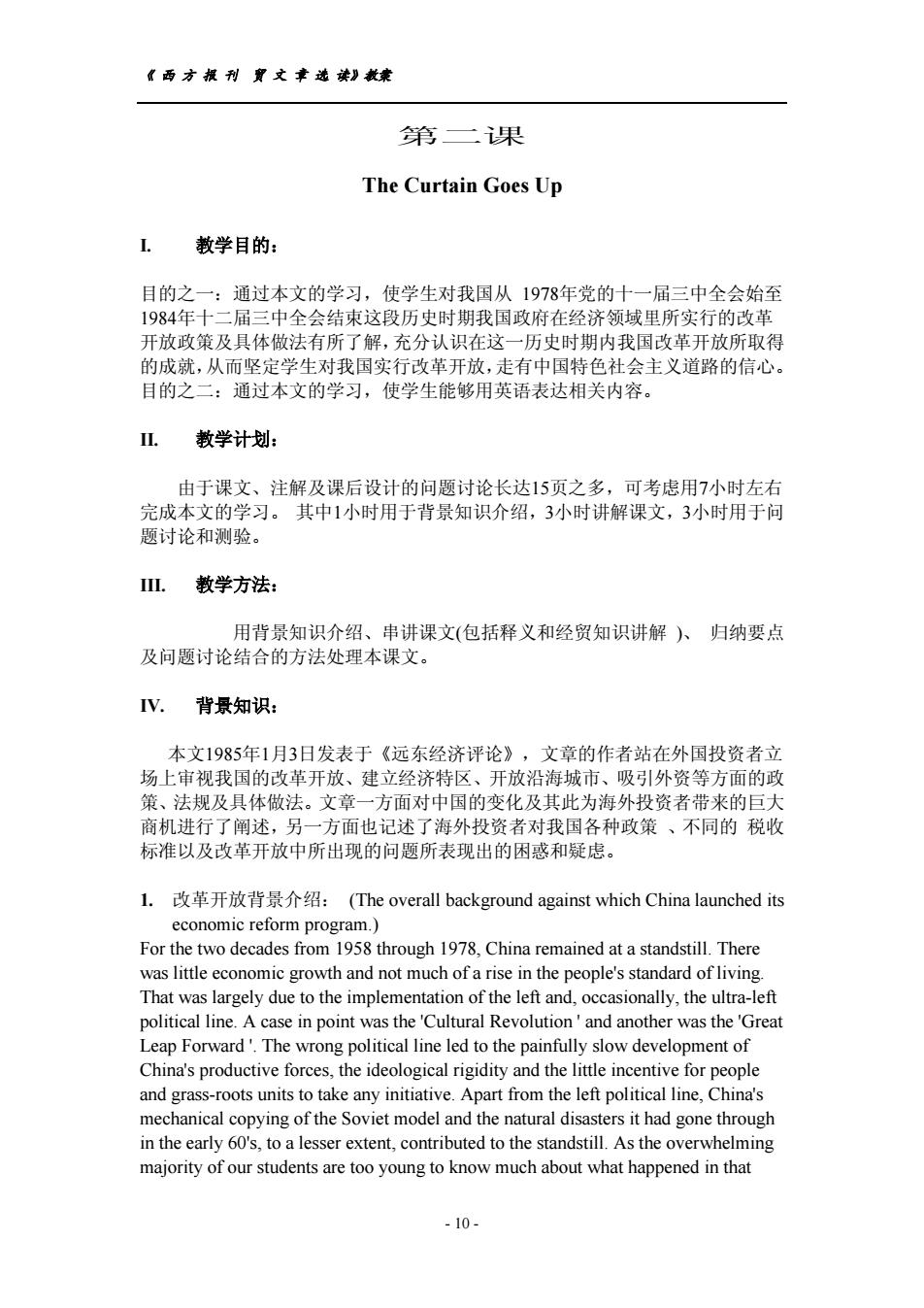
《西方报刊贸文章进读》教球 第二课 The Curtain Goes Up 教学目的: 目的之一:通过本文的学习,使学生对我国从1978年党的十一届三中全会始至 1984年十二届三中全会结束这段历史时期我国政府在经济领域里所实行的改革 开放政策及具体做法有所了解,充分认识在这一历史时期内我国改革开放所取得 的成就,从而坚定学生对我国实行改革开放,走有中国特色社会主义道路的信心。 目的之二:通过本文的学习,使学生能够用英语表达相关内容。 Π 教学计划: 由于课文、注解及课后设计的问题讨论长达15页之多,可考虑用7小时左右 完成本文的学习。其中1小时用于背景知识介绍,3小时讲解课文,3小时用于问 题讨论和测验。 III. 教学方法: 用背景知识介绍、串讲课文(包括释义和经贸知识讲解)、归纳要点 及问题讨论结合的方法处理本课文。 V.背景知识: 本文1985年1月3日发表于《远东经济评论》,文章的作者站在外国投资者立 场上审视我国的改革开放、建立经济特区、开放沿海城市、吸引外资等方面的政 策、法规及具体做法。文章一方面对中国的变化及其此为海外投资者带来的巨大 商机进行了阐述,另一方面也记述了海外投资者对我国各种政策、不同的税收 标准以及改革开放中所出现的问题所表现出的困惑和疑虑。 L.改革开放背景介绍:(The overall background against which China launched its economic reform program.) For the two decades from 1958 through 1978,China remained at a standstill.There was little economic growth and not much of a rise in the people's standard of living. That was largely due to the implementation of the left and,occasionally,the ultra-left political line.A case in point was the 'Cultural Revolution'and another was the 'Great Leap Forward.The wrong political line led to the painfully slow development of China's productive forces,the ideological rigidity and the little incentive for people and grass-roots units to take any initiative.Apart from the left political line,China's mechanical copying of the Soviet model and the natural disasters it had gone through in the early 60's,to a lesser extent,contributed to the standstill.As the overwhelming majority of our students are too young to know much about what happened in that -10-
《 西 方 报 刊 贸 文 章 选 读》教案 - 10 - 第二课 The Curtain Goes Up I. 教学目的: 目的之一:通过本文的学习,使学生对我国从 1978年党的十一届三中全会始至 1984年十二届三中全会结束这段历史时期我国政府在经济领域里所实行的改革 开放政策及具体做法有所了解,充分认识在这一历史时期内我国改革开放所取得 的成就,从而坚定学生对我国实行改革开放,走有中国特色社会主义道路的信心。 目的之二:通过本文的学习,使学生能够用英语表达相关内容。 II. 教学计划: 由于课文、注解及课后设计的问题讨论长达15页之多,可考虑用7小时左右 完成本文的学习。 其中1小时用于背景知识介绍,3小时讲解课文,3小时用于问 题讨论和测验。 III. 教学方法: 用背景知识介绍、串讲课文(包括释义和经贸知识讲解 )、 归纳要点 及问题讨论结合的方法处理本课文。 IV. 背景知识: 本文1985年1月3日发表于《远东经济评论》,文章的作者站在外国投资者立 场上审视我国的改革开放、建立经济特区、开放沿海城市、吸引外资等方面的政 策、法规及具体做法。文章一方面对中国的变化及其此为海外投资者带来的巨大 商机进行了阐述,另一方面也记述了海外投资者对我国各种政策 、不同的 税收 标准以及改革开放中所出现的问题所表现出的困惑和疑虑。 1. 改革开放背景介绍: (The overall background against which China launched its economic reform program.) For the two decades from 1958 through 1978, China remained at a standstill. There was little economic growth and not much of a rise in the people's standard of living. That was largely due to the implementation of the left and, occasionally, the ultra-left political line. A case in point was the 'Cultural Revolution ' and another was the 'Great Leap Forward '. The wrong political line led to the painfully slow development of China's productive forces, the ideological rigidity and the little incentive for people and grass-roots units to take any initiative. Apart from the left political line, China's mechanical copying of the Soviet model and the natural disasters it had gone through in the early 60's, to a lesser extent, contributed to the standstill. As the overwhelming majority of our students are too young to know much about what happened in that